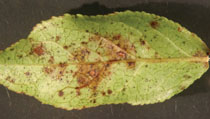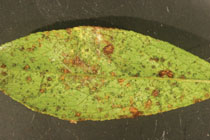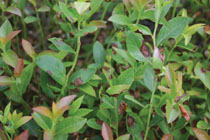
Features
Production
Research
Leaf diseases on the increase
increase in Maritime blueberry plantings
March 6, 2008 By Dan Woolley
An Agriculture and Agri-Food
Canada plant pathologist is urging wild blueberry producers to be on
the lookout for three emerging plant diseases.
An Agriculture and Agri-Food Canada plant pathologist is urging wild blueberry producers to be on the lookout for three emerging plant diseases.
Dr. Paul Hildebrand of the Atlantic Food and Horticultural Research Centre in Kentville, N.S., says Septoria leaf spot, leaf rust and Valdensinia could be potentially devastating diseases for wild blueberry producers and need to be monitored for closely.
 |
| A photo displaying symptoms of Septoria leaf spot on a blueberry leaf. This disease can sometimes be mistaken for leaf rust, another disease of the foliage. |
Septoria leaf spot, caused by Septoria albopunctata, is increasing in prevalence in North America, says Dr. Hildebrand. The disease initially appears as a small, water-soaked lesion on the underside of a leaf. The infected leaves eventually turn reddish-brown in late July and early August, with most of the leaves and some of the blueberries dropping by harvest time.
Septoria can also manifest itself earlier in the year, usually in May, as purplish-brown lesions on the stems of the wild blueberry plants. These lesions contain spore bodies (pycnidia), which produce spores that are then spread by rainfall throughout the month of June.
 |
| A photo showing the symptoms associated with Septoria leaf spot manifesting itself on the stem of a blueberry bush leaf. This is also known as Septoria stem blight. |
Spore bodies can also form on leaf litter, says Dr. Hildebrand, noting the pycnidia found on one leaf can produce up to 20,000 infectious spores.
Septoria infections increase in severity from late May to harvest, with a marked increase in leaf fall as the harvest approaches. This can result in lower crop yields because of bush defoliation.
Dr. Hildebrand says it is important to maintain foliage on wild blueberry plants and adds Bravo will work well as a fungicide. He recommends the spray only be applied to blueberry fields in the non-
bearing year.
Meanwhile, burning a blueberry field in the non-crop year can provide an 11-fold decrease over mowing in the incidence of blueberry stems infected with Septoria, adds
Dr. Hildebrand.
 |
| A photo displaying symptoms of leaf rust on a blueberry leaf. This disease can sometimes be mistaken for Septoria leaf spot, another disease of the foliage. |
Leaf rust
Another disease growers should be scouting for is leaf rust. This sporadic disease, caused by the virus Pucciniastrum vaccinii, principally strikes wild blueberry sprouts. It manifests itself as well-defined reddish lesions with yellow blisters on the bottom of leaves. It’s these blisters that generate spores. With the exception of the blisters, it is hard to distinguish leaf rust from Septoria, says Dr. Hildebrand.
From its alternate host, Hemlock trees, the leaf rust spore can spread to adjacent wild blueberry fields. This usually results in a complete defoliation of the blueberry bush by early September, says Dr. Hildebrand, especially for berry sprouts hit by Septoria in June.
Research work with Bravo fungicide sprays have resulted in a 32 per cent increase in crop yield during field trials and a 39 per cent increase in crop yield with Bravo used as a leaf rust control.
Hildebrand hopes Bravo will soon be registered for application to berry sprouts; but he also recommends growers not apply Bravo in a crop year as the spray residue will prevent fruit shipments to Japan and Europe.
Instead, during a crop year, he suggests growers use Pristine and Switch. Both products are traditionally Botrytis fungicides but will also give some control of Septoria.
“The beauty of these two fungicides is they will spread to all surfaces of the leaf surface after application,” says Dr. Hildebrand.
In co-operation with Dr. David Percival of the Nova Scotia Agricultural College in Truro, Dr. Hildebrand hopes “to do some research on Bravo so as to reduce its residue to satisfy the requirements of Europe and Asia.”
Bravo, “fortunately,” is not very expensive, says Dr. Hildebrand. It can be applied as a control in the first two weeks of August, after sprout growth stops and before leaf
rust spreads.
 |
| An example of the leaf symptoms attached to an outbreak of Valdensinia. The disease first showed up in Nova Scotia in the 1997-1998 crop years in Cumberland County and by 2005 became fairly well established across Nova Scotia. |
Valdensinia
Valdensinia, the third blueberry leaf disease, appears as larger, brown lesions on bush leaves. According to Dr. Hildebrand, the disease first showed up in Nova Scotia in the 1997-1998 crop years in Cumberland County. Following 2005, recalled as a very wet year, the disease was fairly common across Nova Scotia.
Dr. Hildebrand notes Valdensinia has resulted in severe losses in some blueberry plantings through rapid defoliation and the development of berries that will not mature in size. The disease appears in early June close to woods and shaded areas that experience cooler temperatures between 12 and 17 C. The lower temperatures paired with ample precipitation encourage the disease
to develop.
Other plants that host Valdensinia include bunch berry, maple, birch, wild raspberry and wild strawberry, but these plants are not defoliated like blueberry. The pathogen can be spread by both humans and wildlife.
“Do not walk through infected areas,” recommends Dr. Hildebrand, adding growers should also brush their feet before entering healthy berry fields.
During the 2007 season, Dr. Hildebrand sprayed two applications of Pristine on June 7 and 21. This resulted in a 29 per cent defoliation reduction and a significant crop yield increase. Although Valdensinia “has taken off in the last two years,” Dr. Hildebrand believes irrigation is not much of a factor in the disease’s occurrence since irrigation is typically only applied during dry weather, a time when the pathogen is usually not active. ❦
Print this page